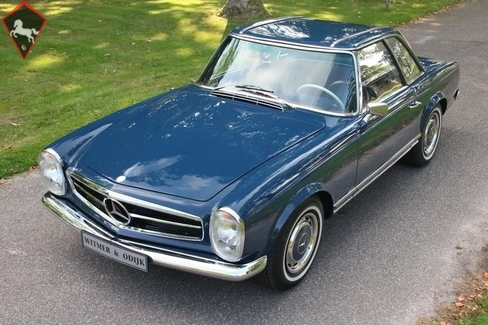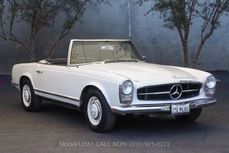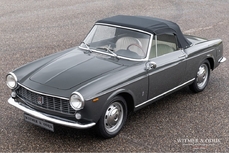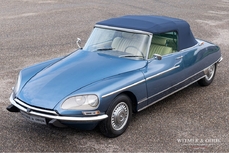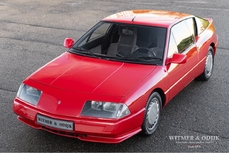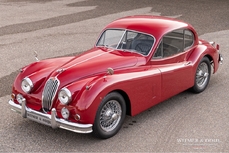Mercedes-Benz 250SL w113 Pagode Automaat 1968
General description :
Model historie en beschrijving:
Hoewel het woord 'pagode' doet denken aan verre exotisch oorden kreeg de W113 serie van Mercedes zijn legendarische bijnaam nadat in een saai Duits industrieel gebouw designer Paul Braque de zo kenmerkende hardtop voor dit model ontwierp. Met als doel goed zicht en voldoende hoofdruimte voor bestuurder en passagier. Het dak knikte, zoals een pagode-dak, door in het midden als gevolg van de vergrote hoofdruimte en diende daarom als naamgever. Opvallend, het was tenslotte een autotype wat nadrukkelijk als roadster in de markt werd gezet. Sterker, de W113 serie moest de toen al legendarische 300SL Roadster gaan vervangen. Een terugkerend stijlelement van deze auto is bijvoorbeeld de gelijkenis van de koplamp. Wat rijeigenschappen betreft was de 113 serie in ieder geval een grote sprong voorwaarts voor Mercedes. Autojournalisten omschreven de wegligging destijds alsof de auto op rails reed. Ook werd voor het eerst serieus aandacht besteed aan het aspect veiligheid, de nieuwe SL was in '64 wereldwijd de eerste sportwagen met een stijve passagiersruimte terwijl koffer- en motorruimte als kreukelzone diende. Om het wagengewicht te drukken werden deurpanelen, motorkap en kofferklep uitgevoerd in aluminium. Hoewel de typeaanduiding staat voor Sport en Leicht werd, ondanks het gebruik van lichtere materialen, de SL meer een comfortabele toerauto dan een spartaanse sportauto. Deze 250SL is in 2013 geheel gerestaureerd en nieuw opgebouwd. Echt alles werd gereviseerd of vernieuwd. Een dergelijk project kost al snel meer dan de huidige verkoopprijs van de auto. Vanzelfsprekend is de auto optisch in 'nieuwstaat' en brengt ze u betrouwbaar waar u maar wilt.
Uitrusting:
Opties waren in die tijd niet de winstpakkers van Mercedes. Deze 250SL heeft een fraaie tijdcorrecte radio, waar de meeste SL's skai op de stoelen hebben is hier mooi donkerblauw leer gebruikt en er zijn fraaie donkerblauwe velours matten.
Exterieur:
In kleurnummer 350H, Medium Blue, uitgevoerde carrosserie. Zeer fraai strak en roestvrij plaatwerk, perfect foutloos gespoten. De gehele auto is vrij van beschadigingen. De lakkwaliteit is hoog en heeft een mooi diepe glans. Het chroomwerk is rondom vernieuwd en contrasteert fraai met het donkere blauw. De donkerblauwe cabriokap is eveneens nieuw. Ook de bodem is hard, roestvrij en origineel. Een prachtige stijlvolle 250SL voor wie wil rijden én poetsen.
Interieur:
Ook hier is alles foutloos in nieuwstaat. Mooi diep donkerblauw leer op de stoelen, deurpanelen en dashboard. Diep donkerblauw velours bekleding en matten op de vloer en dorpels. Alle meters zijn goed afleesbaar en werken zoals het hoort. Het hout is nieuw gelakt. De stoelen zijn eveneens gerestaureerd en nieuw gevuld, perfecte steun biedend. Het ivoor kleurige stuur is een lust voor het oog en in nieuwstaat.
Motorruimte, kofferruimte, velgen & banden:
In de motorruimte is ook alles duidelijk zichtbaar aangepakt. Alle techniek werd gedemonteerd en pas nadat het getest goed werd bevonden weer teruggebouwd. De auto rijdt derhalve uitstekend. Start direkt, loopt mooi rond, rookt niet en de oliedruk is perfect. Originele typeplaatjes aanwezig. De kofferruimte is voorzien van een nieuwe mat en ook de bodem is hier foutloos. Een volwaardig reservewiel en gereedschap hier aanwezig. De fraaie velgen krijgen van ons nog de juiste nieuwe Michelin banden mee.
Service geschiedenis:
Nieuw verkocht in 1968 in Italië. Europese uitvoering. In 2013 omvangrijk vakkundig gerestaureerd en sindsdien nauwelijks gebruikt. Derhalve in zeer fraaie en goed rijdende conditie. Wordt geleverd inclusief hardtop, Nederlands kenteken in 'oud blauw', nieuwe APK en onderhoudsbeurt.
Kilometerstand51.366 Vermogen150 pk
Bouwjaar1968 Cilinderinhoud2498 cc
Kleur exterieurBlauw Motor configuratie6 cylinder lijn met injectie
Kleur interieurDonkerblauw Motor nummerMatching
BekledingLeer Velgen15 inch MB staal
0 - 100 km/u7,9 sec BandenMichelin
Topsnelheid195 km/u Productieaantallen 2460
Chassisnummer11304312001314 OverigNieuw opgebouwd.
http://www.witmerodijk.nl/te-koop/mercedes-benz-250sl-pagode-1968/629
1968 Mercedes-Benz 250SL w113 Pagode Automaat is listed sold on ClassicDigest in Warmond by Auto Dealer for €89950.
Car Facts
Car type : Car Make : Mercedes-Benz Model : 250SL w113 Model Version : Pagode Automaat Engine size : 0.0 Model Year : 1968 Location : Wasbeeklaan 3A, 2361 HG Warmond, Netherlands
Sold
Seller Information
Sold
People who viewed this Mercedes-Benz 250SL w113 also viewed similar Mercedes-Benz listed at ClassicDigest
Other cars listed for sale by this dealer
About Mercedes-Benz
In the annals of automotive history, the journey of Mercedes-Benz is a tale that unfolds with the ingenuity of its founding pioneers. In the year 1886, Karl Benz crafted the Benz Patent Motorwagen, a creation that would go down in history as the world's inaugural automobile. Unbeknownst to him, this moment marked the genesis of what would evolve into the most illustrious premium car manufacturer globally. The financial underpinning of this pioneering venture, interestingly, was provided by Karl Benz's wife, Bertha Benz, demonstrating a remarkable partnership that would set the tone for Mercedes-Benz's legacy.A parallel narrative emerged not far away, as Daimler-Motoren-Gesellschaft, founded by Gottlieb Daimler and Wilhelm Maybach, entered the scene. In 1901, they unveiled their automobile under the now-famous moniker "Mercedes," meaning "godsend" in Spanish. This name was bestowed upon the car at the behest of Emil Jellinek's daughter, the distributor for Daimler-Motoren-Gesellschaft. The wheels of innovation were set in motion.
Fast forward to 1926, a pivotal year that witnessed the merger of Daimler with Benz & Cie., culminating in the birth of Daimler-Benz. The amalgamation saw the adoption of "Mercedes-Benz" as the distinguished trademark for their automobiles, fusing the legacies of two visionary entities into one.
Contrary to perceptions of conservatism, the trajectory of Daimler-Benz unfolds as a chronicle of industry firsts. From the introduction of the honeycomb radiator to the float carburetor, and the pioneering implementation of four-wheel brakes in 1924, Daimler-Benz consistently pushed the boundaries of automotive innovation. The diesel-powered Mercedes-Benz 260 D in 1936 marked the inception of diesel engines in passenger cars. The iconic Mercedes-Benz 300SL Gullwing made history as the first car with direct fuel injection, albeit the Gutbrod's tiny 2-stroke engine can claim precedence.
Safety innovations became a hallmark, with Béla Barényi's patented safety cell design in the "Ponton"-models in 1951, featuring front and rear crumple zones. The W116 450SEL 6.9 saw the introduction of the Anti-Lock Brake system (ABS), another pioneering safety feature. From the first production airbags and beyond, the legacy of "firsts" continued to be etched into the fabric of Daimler-Benz.
Over its centennial journey, Mercedes-Benz has not merely produced cars but has sculpted automotive icons. The SSKL, 710 SSK Trossi Roadster, 770K Grosser, 540K Spezial Roadster, 300SL Gullwing, w100 600 Pullman, w111 280SE 3.5 Flachkühler, w113 230SL Pagoda, w109 300 SEL 6.3, and w201 2.3-16 Cosworth stand testament to the brand's commitment to engineering excellence.
The roaring Silver Arrows, or "Silberpfeile," including the W 25, W 125, W154, W165, and W196, created a legacy of dominance on the racetrack. These machines were not merely cars; they were expressions of precision, speed, and an indomitable spirit that left their competitors in the dust.
As Mercedes-Benz marches into the future, it does so not just as an automaker but as a custodian of a legacy, a torchbearer of innovation, and a beacon of automotive excellence. The road ahead is sure to witness the continued fusion of cutting-edge technology, timeless design, and an unwavering commitment to setting new standards in the world of automobiles.
One luminary figure who left an indelible mark was Béla Barényi, often heralded as the "father of passive safety" for his pioneering work in safety engineering. His patented safety cell design, featuring front and rear crumple zones, became a hallmark of Mercedes-Benz's commitment to occupant safety, setting new standards that reverberated throughout the automotive world.
Moving through the chronicles, the collaborative genius of Wilhelm Maybach, alongside Gottlieb Daimler, laid the foundation for Daimler-Motoren-Gesellschaft. Their innovations not only birthed the first Mercedes but established a culture of relentless pursuit of technological excellence that remains integral to Mercedes-Benz's DNA.
In the post-merger era of 1926, Ferdinand Porsche emerged as a prominent figure within Mercedes-Benz. His work on the Mercedes-Benz S-Type, a supercharged race car, garnered acclaim and set the stage for a legacy that extended far beyond the marque. Porsche's impact would later extend to his eponymous company, but his influence at Mercedes-Benz during those formative years was pivotal.
As the 20th century progressed, the legendary Rudolf Uhlenhaut emerged as a key figure. Uhlenhaut, an accomplished engineer and the driving force behind the iconic Silver Arrows, played a crucial role in Mercedes-Benz's dominance in motorsports. His engineering prowess and attention to detail were instrumental in creating some of the most formidable racing cars of the era.
In the latter half of the century, figures like Bruno Sacco, the head of design at Mercedes-Benz from 1975 to 1999, left an indelible imprint on the brand's aesthetic identity. Sacco's design philosophy, characterized by clean lines and timeless elegance, shaped iconic models like the W126 S-Class and the W201 190E, solidifying Mercedes-Benz's reputation for luxury and sophistication.
The narrative would be incomplete without acknowledging the contributions of engineers like Hans Scherenberg, whose leadership in the 1970s ushered in a new era of technological innovation at Mercedes-Benz. Scherenberg's tenure saw the development of groundbreaking technologies, including the Anti-Lock Brake system (ABS) and the introduction of airbags in production cars.
